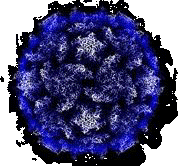HUMAN POLIOVIRUS 1
"Upon enter(o)ing man, I am able to pic[orna] on his abilities to walk."

DESCRIPTION
This virus is a member of the Picornaviridae family, which is small (30 nm) and stable. It is composed of a positive-sense, single-stranded RNA genome and an icosahedral capsid. It belongs to the genus Enterovirus.
Poliovirus was the first enterovirus to be discovered. In 1908, the basic study of the virus began and this is when Landsteiner transmitted the disease to monkeys. The reason that it was denoted as an enteric disease resulted from studies conducted by Paul and Trask in the 1930s when they collected feces of patients and healthy carriers and recognized the virus in the feces of both. After an epidemic in North Carolina in 1948, antibodies against type 1 were acquired. The number of subclinical infections of type 1 were recognized to be approximately 100, although a bit higher in infancy. Then in the 1950s the polioviruses became a group of a larger viral family, Picornaviridae.
POWER
The virulence is typically low, as most cases are asymptomatic. In rare cases, it is serious.
OFFENSES
ATTACKS
The attack of poliovirus begins in the tonsils, lymph nodes of the neck, and small intestine. It then invades the central nervous system through the bloodstream. It also infects nerve cell types, and thus can damage or completely destroy these cells.
The route of entry for most polioviruses is the alimentary tract via the mouth. Thus the route of transmission is fecal-oral in areas with poor sanitation. Typically this virus is present in the feces for several weeks and in the pharynx for up to 2 weeks after infection. In other areas, transmission is respiratory.
OUTCOME
The most common form of infection by the poliovirus is asymptomatic or is displayed by malaise, gastrointestinal upset, and fever. The most serious disease that results from poliovirus is poliomyelitis. The symptoms of this paralysis incorporate aseptic meningitis, fever, headache, meningism, muscle pains, and finally muscle paralysis, commonly asymmetrical.
Poliovirus 1 can cause paralysis, ranging from slight to complete weakness of the muscles. In between 1 of 100 or 1 of 1000 cases this virus may lead to central nervous system involvement and paralysis. This is caused by permanent damage incurred in the anterior horn motor neurons of the spinal cord. It can also cause aseptic meningitis and undifferentiated febrile illness.
SPEED
Man is the only known reservoir, which identifies this virus as eradicable.
The incubation period for the gastrointesinal disease is 3 to 21 days and is typically between 7 and 14 days for the paralytic disease.
DEFENSES
VACCINES
There are two vaccines for the poliovirus. One is the inactivated polio vaccine (Salk). It was developed in 1957 by mixing the 3 serotypes of the poliovirus and killing the mixture with formalin. This vaccine has proven to not be as effective as it requires 3 injections at 3 to 6 months of age and later boosters. Furthermore, it is more expensive than the other vaccine because of the need for great amounts of antigen. The live, attenuated vaccine (Sabin), on the other hand, proves more cost-effective and it produced long-lasting immunity quickly. This vaccine was developed in 1963 by attenuating the three strains, which allowed it to diminish in neurovirulence. It is more easily administered orally, which does not require highly trained medical personnel. It too is given 3 times with boosters. This particular vaccine confers both humoral and intestinal immunity. The Sabin vaccine is used in most countries.
The function of the boosters for these vaccines is to prevent viral replication in the gut.
BEHAVIORAL
It has been proven that quarantine of the patients does not prove effective in controlling the spread of the poliovirus.
Once exposed to the disease, lifelong immunity is conferred for that specific type of poliovirus, as subsequent infection with other strains are still able to occur.
TREATMENT
No anti-viral drugs have been discovered for poliovirus.
GAME ACTION
Once you receive this card, you will receive a booster of the Sabin vaccine and it is your duty, as an officer of the Center for Disease Control, to establish a plan for worldwide eradication.